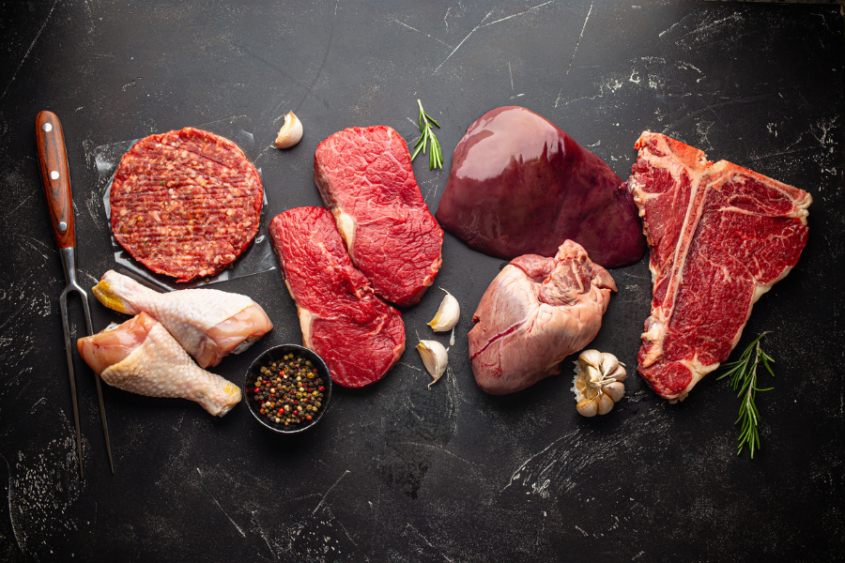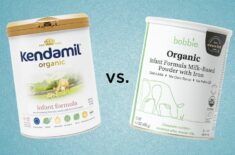Overview
Are you looking to add meat to your baby’s diet?
Your baby might just surprise you and turn out to be a meat-lover in their early months! Meat is a great baby food option because it’s nutrient-dense and rich in iron, protein, B vitamins, and more.
Did you know that by the time your baby reaches seven months old, they require more iron than an adult male? That’s right. Your baby needs at least 11 mg/day of iron. (1)
As soon as your baby starts on solid foods, it’s important to introduce iron-rich foods to help prevent illnesses like anemia. Meat is a good source of heme iron, the type of iron found in animal products, which is easily absorbed by the body. (2)
It’s convenient to prepare because it can be shared with the rest of the family. Meat is also freezer-friendly, so you can make plan-ahead meals.
However, offering meat to your baby isn’t an absolute must, especially if your family doesn’t eat meat. If this is the case for you, other food options such as fruits and green leafy vegetables like spinach can fulfill your baby’s nutritional needs.
This article discusses how to safely introduce meat to your baby following the baby-led weaning methodology. We’ve listed down different ways to serve meat and how to find the best meat options. We’ve also detailed directions on cutting meat safely per age. For all your questions about meat in baby-led weaning and more, we got you covered!
What’s BLW?
Baby-led weaning (BLW) skips traditional purée spoon-feeding and lets your baby take the lead in feeding themselves with appropriately-sized finger foods. BLW promotes independence as your baby decides what and how much to eat. It also encourages healthy eating habits and can make feeding time convenient because your baby can join the rest of your family during mealtimes.
Meat In Baby-Led Weaning
How Often Should Babies Eat Meat?
Experts recommend that babies four to six months of age who are already eating solid foods consume one to two tablespoons of meat twice a day. By seven months old, they can start consuming two to three tablespoons of meat twice a day. (3)
The Best Meats To Serve Your Baby
When it comes to feeding your baby meat, it’s best to offer different types of meats. Here are some of the best meats you can offer to your baby:
Red meat like beef, pork, goat, or lamb – Made into meatballs, cut into long strips, shredded, pureed, or ground. You can also serve ribs, meat on a bone, or lamb chops.
Poultry like chicken or turkey – Offer drumsticks, shredded, meatballs, finger-sized log shapes, ground, or pureed.
Low-mercury fish like sardines, salmon, or tilapia – Steamed, broiled, or baked.
Aside from conventional meat options, you can be adventurous and go for small amounts of veal, chicken liver, goat, or buffalo meat. You can even offer very small amounts of organ meats like kidneys and heart.
Healthier Meat Sources: Choosing Organic
While conventional meats are completely safe and nutritious for your baby, you can also choose healthier meat options. Choose organic, grass-fed, pasture-raised, wild-caught, and free-range meat whenever possible.
Conventional meat usually contains antibiotics and growth hormones, which can cause side effects and contribute to antibiotic resistance. Eating meat with growth hormones can lead to the early onset of puberty. Since your baby is highly susceptible to infections and diseases, keeping them away from harmful chemicals and substances is best. (4)(5)
Top Reasons To Serve Meat In BLW
Nutrition Facts
Here’s the nutritional content of beef per 3 oz or 85 grams: (6)
- Calories – 197.2 kcal
- Protein – 20.93 g
- Fat – 11.92 g
- Carbohydrates – 0
- Fiber – 0
- Iron – 2.28 mg
- Potassium – 296.65 mg
- Phosphorus – 179.35 mg
- Calcium – 17 mg
- Selenium – 17.26 mcg
Chicken or poultry per one cup: (7)
- Calories – 412.8 kcal
- Protein – 35.49 g
- Fat – 29.02 g
- Carbohydrates – 0
- Fiber – 0
- Iron – 1.95 mg
- Potassium – 232 mg
- Calories – 412.8 kcal
- Calcium – 28.8 mg
- Vitamin A – 492.8 IU
Pork per 1 oz or 3 grams: (8)
- Calories – 171.7 kcal
- Protein – 25.66 g
- Fat – 6.86 g
- Carbohydrates – 0
- Fiber – 0
- Iron – 0.72 mg
- Phosphorus – 204.85 mg
- Calcium – 26.35 mg
- Potassium – 318.75 mg
Meat Is Rich In The Right Kind Of Iron
Iron is an important nutrient because it helps produce hemoglobin, which transfers oxygen to the cells through the blood. If your baby doesn’t get enough iron, they can develop different forms of iron deficiency ranging from mild to severe anemia. When that happens, your baby’s ability to learn and develop can be affected. (9)
Your baby’s iron needs are supplied by breast milk or infant formula for the first six months of their life. However, their nutritional requirement for iron increases significantly as they get older.
That’s why experts recommend introducing your baby to iron-rich foods at around six months of age or as soon as they start eating solid foods. (9)
There are two sources of iron:
Heme iron, which is commonly found in meats and is more easily absorbed by the body.
Good sources include: (10)
- Red meat (beef, lamb, goat, or pork)
- Poultry (chicken or turkey)
- Eggs
- Seafood (fatty fish like salmon)
Non-heme iron, which is commonly found in plants and is less easily absorbed by the body. Sources of non-heme iron include: (10)
- Beans
- Green leafy vegetables like spinach
- Lentils
Experts suggest pairing iron-rich food with foods rich in vitamin C, like fruits, to help absorb iron.
Meat Contains Loads Of Essential Nutrients For Brain Development
These are the key nutrients that support your baby’s brain development and mental functioning:(11)(12)
Iron – When your baby doesn’t have enough iron, they may have trouble concentrating, which can affect their learning ability. (2)
Zinc – This nutrient aids in your baby’s motor development and helps them become more active and playful. (13)
Choline – Influences brain development and function. It also plays a role in your baby’s learning and memory. (14)
Iodine – Iodine deficiency can lead to brain damage and can reduce your baby’s cognitive function. (15)
Vitamins A, D, B6, and B12 – Vitamins A promote better eyesight, while vitamin D helps make strong bones. B vitamins aid your baby’s brain development in producing healthy red blood cells. (16)(17)
Omega-3 fatty acids- Fatty acids like DHA and EPA are “foods for the brain” to help keep it healthy. (18)
Food Safety With Meat
Is Meat A Choking Hazard?
Yes, tough or large chunks of meat are included in the USDA (United States Department of Agriculture) list of common choking hazards. (19)
To reduce the risk of choking, cook meat until it’s soft and tender. You should also cut meat according to your baby’s age. You’ll find more detailed instructions on how to cut meat appropriately below.
Meat can be shredded, pureed, ground, or served as mini meatballs. Always supervise your baby while eating, especially high choking risk foods like meat.
Is Meat An Allergen?
Meat allergy is considered uncommon. However, it can still happen. Alpha-gal syndrome is a food allergy to red meat and other meat products. It’s associated with a bite from a Lone Star tick, usually found in the southeastern United States. (20)(21)
Here are some common symptoms of alpha-gal and meat allergy: (21)
- Swelling of the face, lips, throat, tongue, or other body parts
- Shortness of breath or difficulty breathing
- Itchy skin or eczema
- Stomach pain
- Diarrhea
- Nausea
- Vomiting
- Headaches
- Anaphylaxis, a severe, life-threatening allergic reaction
If your immediate family has a history of food allergies or a meat allergy, in particular, it’s best to consult your baby’s pediatrician or registered dietitian before introducing any meat products.
Can Babies Eat Medium-Rare Meat?
When it comes to your baby’s food safety, there’s no “medium-rare” or “rare” food. For their little tummies, well done is the safest option. By making sure that meat is cooked all the way through, harmful bacteria like E. Coli are killed.
Meat Products To Avoid
Keep your baby away from processed meat products that contain added nitrates and high levels of sodium. These compounds are used to cure meat and have been linked to several health concerns, such as methemoglobinemia, a condition known as “blue baby syndrome.” When this occurs, the blood cannot circulate oxygen properly, causing babies to turn blue. Added nitrates are also linked to cancer. (22)(23)
Avoid:
- Hotdogs
- Ham
- Bacon
- Nuggets
- Liver pâté
- Sausage
Food Safety Tips When Cooking & Preparing Meat
Since your baby is susceptible to bacteria and germs, it’s important to safeguard them from the risk of diarrhea, infection, or food poisoning.
Here are some tips when cooking meat for your baby: (24)
- Always make sure meat is thoroughly cooked but still moist and soft to chew. Undercooked or raw meat can be a breeding ground for bacteria and can cause diseases like “hamburger disease,” a type of food poisoning caused by a bacteria called E. coli. (24)
- To know if ground beef and patties are well cooked, make sure that the center is brown and not pink or red.
- Chicken and turkey should be well cooked with no red parts near the bone.
- To ensure that meat is cooked, you can also use a food thermometer. It should be cooked at 165 F or higher for poultry, while beef and pork should be cooked at 160 F or higher. (25)
- Keep your meat juicy by cooking with the skin but removing it before serving.
- Instead of frying, you can broil, boil, or steam meat, so it helps preserve its nutrients. Let meat cook in a slow cooker if you have time.
Some tips when preparing meat:
- Always keep your hands clean when you touch any raw meat.
- To avoid cross-contamination, thoroughly wash equipment and utensils that have been in contact with raw meat.
- Raw meat should be placed in covered containers and away from other foods in the fridge.
When Can Babies Eat Meat In Baby-Led Weaning?
Meat can be a good choice as your baby’s first food. The AAP (American Academy of Pediatrics) suggests introducing solid food at six months, provided babies show signs of readiness.
Here are the top three questions to keep in mind: (26)
Can my baby swallow food?
Can my baby hold their head in an upright position and sit with no support?
Can my baby pick up the food and put it in their mouth?
Can You Give Meat To A Six-Month-Old Baby?
Absolutely! Your baby can benefit from all the nutrients, minerals, and vitamins like iron, protein, and B vitamins that meat offers.
When introducing meat or any new food to your baby, it’s advisable to give it in small amounts and wait for two to three days for any allergic reactions such as rashes or vomiting.
First Time
You can start by offering meat with a milder taste and texture, such as chicken. Try offering a drumstick for your baby to hold. You can also have it mashed, pureed, or cut into strips.
When offering meat, stick to one kind for two to three days to look out for any allergic reactions. It’ll also give your baby more time to get used to the new taste and texture.
6 Quick & Simple Ways To Serve Meat In BLW
-
- Purée – Place cooked meat in a blender or food processor with a little bone broth or water. Blend until it’s smooth enough to run on a spoon easily.
- Mini Meatballs – Mix minced or ground meat with breadcrumbs, eggs, or sweet potatoes. Form into small meatballs that’ll fit into your baby’s hands. Bake for 15 minutes or until firm.
- Meat On The Bone – Offer drumsticks or spare ribs to your baby. The bone makes for a perfect handle as your baby learns to self-feed.
- Meat Patties – Mix ground beef or pork meat and use eggs or flax eggs as a binder. Flatten meatballs to form mini burger patties.
- Mashed Meat With Veggies – Steam or slow cook meat until tender enough to mash. Mix in mashed potatoes or softened carrots for added nutritional value.
- Chunks Of Meat – Meat is a good finger food option, so cut them in appropriate sizes according to your baby’s age. We have detailed instructions on how to cut meat correctly below.
How Do I Cook Meat For My Six-Month-Old?
There are many ways you can safely cook meat for your six-month-old baby. You can offer meat on a bone, meatballs, meatloaf, or mashed. Check out our section above on quick and simple ways to serve meat.
Best Cooking Temperatures
Beef, lamb, or veal
Pieces or cuts: Well done at 170F (27)
Patties or ground meat: 160F
Pork
Pieces or cuts: 160F (27)
Patties or ground: 160F
Poultry
Breasts or roast: 165F (27)
How Do You Cut Meat For Baby-Led Weaning?
For 4-6 Months Old
When it comes to offering meat as finger foods, they should be big enough to fit in your baby’s little hand with a portion sticking out. This lets your baby have a firmer hold on the meat, reducing the risk of choking. Let your baby grab a drumstick or big chunk of pork chop they can suck or chew. (28)
For 6-9 Months Old
Your baby will now be more comfortable with finger foods at this age, so offer thick slices of meat cut into two to three-inch strips. There should be no sharp or brittle bones when offering meat in bone.
For 9-12 Months Old
Most babies have developed their pincer grasp, or the ability to hold objects between their thumb and pointer finger. This allows them to pick up shredded or small pieces of meat. You can now offer thinner meat slices.
For 12+ Months Old
Continue to offer bite-sized or smaller pieces of meat, ribs, or drumstick to your baby. Once you notice that your baby is comfortable with meat, offer thick slices of meat for biting and tearing. At this age, thinner slices of meat are safer.
How To Store Meat
Pureed or strained meat – store in the fridge for one day and in the freezer for one to two months. (29)
Homemade baby foods – store in the fridge for up to two days and the freezer for three to four months. (29)
FAQ
What If My Baby Rejects Meat?
The rule of thumb in BLW is to let your baby decide on what they want to eat from the choices you offered. If your baby isn’t too keen on eating meat, you can offer a variety of other iron-rich foods to keep a balanced diet.
You can also offer non-heme iron sources such as green leafy vegetables. To help absorb iron, you can pair non-heme sources with vitamin C-rich foods like citrus fruits.
Do keep in mind that sometimes you’ll need to introduce baby to a food as many as 15 times before they warm up to it!
Is It OK To Not Give Baby Meat?
If your family is on a vegan diet, you may choose to let your baby feed on a healthy, well-balanced vegan diet, as long as you consider your baby’s nutrient profiles and needs.
Can Babies Chew Meat Without Teeth?
Yes, your baby can still “chew” meat even if their teeth haven’t come in yet. Thanks to your baby’s strong gums, they can gnaw or chew foods.
Your baby will likely develop their back molars for proper chewing when they reach at least 12 months of age. Until then, your baby will continue practicing their chewing skills. (30)
REFERENCES
:
- https://ods.od.nih.gov/factsheets/Iron-HealthProfessional/#h2
- https://www.cdc.gov/nutrition/infantandtoddlernutrition/vitamins-minerals/iron.html
- https://www.stanfordchildrens.org/en/topic/default?id=feeding-guide-for-the-first-year-90-P02209
- https://www.cdc.gov/drugresistance/food.html
- https://www.news-medical.net/health/Sex-Hormones-in-Meat-and-Dairy-Products.aspx
- https://www.urmc.rochester.edu/encyclopedia/content.aspx?contenttypeid=76&contentid=23569-1
- https://www.urmc.rochester.edu/encyclopedia/content.aspx?contenttypeid=76&contentid=05052-1
- https://www.urmc.rochester.edu/encyclopedia/content.aspx?contenttypeid=76&contentid=10042-1
- https://www.ncbi.nlm.nih.gov/pmc/articles/PMC2528681/#!po=37.5000
- https://www.cdc.gov/nutrition/infantandtoddlernutrition/vitamins-minerals/iron.html
- https://publications.aap.org/aapnews/news/6218
- https://meatscience.org/TheMeatWeEat/topics/meat-in-the-diet/nutrients-in-meat
- https://pubmed.ncbi.nlm.nih.gov/11509102/
- https://www.mdpi.com/2072-6643/12/6/1731/htm
- https://www.unicef.org/rosa/press-releases/nearly-19-million-newborns-risk-brain-damage-every-year-due-iodine-deficiency
- https://kidshealth.org/en/kids/vitamin.html
- https://www.cdc.gov/breastfeeding/breastfeeding-special-circumstances/diet-and-micronutrients/vitamin-b12.html
- https://www.eatright.org/food/vitamins-and-supplements/types-of-vitamins-and-nutrients/do-kids-need-omega-3-fats
- https://www.cdc.gov/nutrition/infantandtoddlernutrition/foods-and-drinks/choking-hazards.html
- https://acaai.org/allergies/allergic-conditions/food/meat/
- https://www.mayoclinic.org/diseases-conditions/alpha-gal-syndrome/symptoms-causes/syc-20428608
- https://www.ncbi.nlm.nih.gov/pmc/articles/PMC7464959/
- https://healthychild.org/how-to-avoid-added-nitrates-and-nitrites-in-your-food/
- https://www.nhs.uk/conditions/baby/weaning-and-feeding/childrens-food-safety-and-hygiene/
- https://extension.umn.edu/preserving-and-preparing/making-safe-baby-food
- https://www.unicef.org.uk/babyfriendly/wp-content/uploads/sites/2/2008/02/Start4Life-Introducing-Solid-Foods-2015.pdf
- https://www.canada.ca/en/health-canada/services/general-food-safety-tips/safe-internal-cooking-temperatures.html
- https://www.nhs.uk/conditions/baby/weaning-and-feeding/babys-first-solid-foods/
- https://www.canr.msu.edu/news/keeping_your_babys_food_safe
- https://www.stanfordchildrens.org/en/topic/default?id=the-growing-child-1-year-olds-90-P02260












